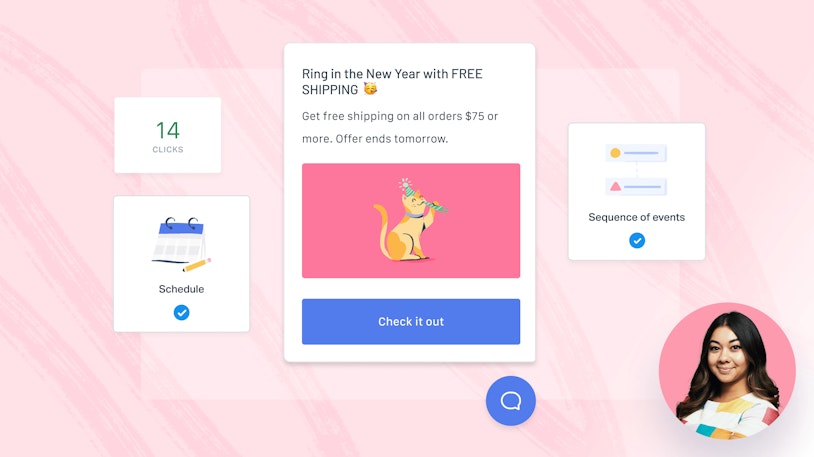Almost anyone with a decent internet connection can start an ecommerce business in 2024 — the tools are readily available.
However, sustaining and growing that business over time is a much bigger challenge. Competition for this year’s estimated $6.3 trillion in ecommerce spending is fiercer than ever.
In this guide, we’ll give you all the tools you need to build a truly customer-centric ecommerce business that attracts and retains a loyal customer base through exceptional service.
Table of contents:
Learn the seven best practices for effective customer service
Attract, delight, repeat: Turn ecommerce buyers into repeat customers
Reduce and handle ecommerce shipping cost complaints
Scale your ecommerce company and customer service
Ecommerce ideas and inspiration
Stories about ecommerce companies putting their customers first
Choosing the best customer service platform for ecommerce
What is ecommerce?
Ecommerce, or electronic commerce, simply refers to buying and selling online. This can include buying and selling physical products, software and digital goods, and services. However, it’s most commonly used to refer to physical products.
There are three main types of ecommerce businesses:
Business-to-business (B2B): This includes software like Help Scout or business services like consulting.
Business-to-consumer (B2C): This includes sites from Target to small Etsy shops that sell to consumers.
Consumer-to-consumer (C2C): This includes marketplaces like eBay where customers sell to each other.
Ecommerce is a popular business model because it has a lot of advantages over shopping in person at brick-and-mortar stores. For example, ecommerce businesses have much lower overhead costs since they don’t have to pay for rent or upkeep of a physical store. Ecommerce business owners can also reach a much wider — even global — audience.
Ecommerce tips and tutorials
Learn the seven best practices for effective customer service
As technology grows more and more integral to our lives, turning to our phones and devices for instant gratification has become second nature when we want to solve a problem, get an answer, or purchase something.
As a result, online shopping is growing at breakneck speed, and there’s no longer a product or category that doesn’t belong online. But in the battle for consumer attention, what can businesses do to be more competitive?
The short answer: Deliver the best possible customer service.
Your customer service team is at the forefront of the business and plays a key role in building relationships and trust with customers. That’s why creating stellar customer experiences can be a game changer for your company.
In this article, learn seven ways to step up your ecommerce customer service game. Here’s a sneak peek at the first tip:
Get organized. One of the essential aspects of a successful customer service department is organization.
You might have an efficient process and a highly motivated team, but without organization, things will likely fall apart. Keeping track of customer conversations and equipping your team with tools that help them collaborate keeps everyone on the same page (so nothing slips through the cracks).
Using a shared inbox, saved replies for repeated questions, and collision detection will empower your customer service team to solve customers’ requests in an organized, efficient manner.
Read on for the next six tips, including examples of top-notch service in practice! Get the full article here.
Attract, delight, repeat: Turn ecommerce buyers into repeat customers
Watch the webinar below to learn how exceptional customer service can drive repeat ecommerce customers — featuring Eryn Chesney, customer experience manager at Mabel's Labels, Dan Caldwell from Klaviyo, and Kristen Bryant Smith, VP of brand at Help Scout.
Reduce and handle ecommerce shipping cost complaints
Shipping costs are a critical factor in ecommerce sales and consistently a top concern of ecommerce shoppers.
In a review of cart abandonment research, Baymard Institute noted that nearly half of all abandoned purchases were due to non-product costs (e.g., shipping, taxes, and fees). While many customers will walk away without ever speaking to your company again, there are plenty who will share their displeasure with customer service staff.
Here are some common causes of shipping price complaints:
Raw cost: Some items are expensive to move because of their size or weight, and there’s no way around it.
Lack of knowledge on shipping costs: Many consumers just don’t understand how expensive shipping is (often because those costs are hidden from them by larger retailers).
Disappointment: When a customer finds the exact thing they need at an acceptable price but later discovers that shipping costs make it unaffordable, that disappointment is understandable.
Mismatched expectations: If a website offers free shipping but the customer’s particular location or product choice does not qualify, those unmet expectations can create problems.
However, the largest cause of shipping cost complaints is also the most basic: that there is any shipping cost at all.
Read the full article to learn exactly how small ecommerce companies can compete on shipping costs, five tips for responding to shipping cost complaints, and how to create an ecommerce shipping policy page (with four great examples)!
Scale your ecommerce company and customer service: More resources and guides
Deliver outstanding online customer support
Getting Started with Social Media Support: A Guide by Help Scout
How To Optimize Your Support Strategy for Messaging Channels
Scale your ecommerce business
5 Funding Options: Choosing the Right Path for Your Business
Color Psychology in Marketing and Branding is All About Context
How to Name a Company or Product: Tips for Choosing a Name That Resonates
From Creator to Coach: Founders Share Lessons from the Transition to CEO
Grow and delight your customer base
Ecommerce ideas and inspiration
We’re always on the lookout for ecommerce businesses and Help Scout customers who are growing their companies with purpose, putting values and customers at the center. In this section, take a look through our selection of inspiring (and educational!) stories from the ecommerce space.
Business is blooming: A lush look inside The Sill's new storefront
Founder and CEO Eliza Blank reflects on 10 years of growing an online-first business that delivers on its mission: to reconnect people with nature, no matter where they live and work. Take a photo tour through The Sill’s newest storefront, and hear from Eliza about how she’s managed to stay laser-focused on her personal and professional growth.
Spikeball is a Help Scout user for life: Here's why
The switch from Zendesk to Help Scout gave the Spikeball team a support solution that’s easy to use — and more importantly, it empowered them to increase efficiency without compromising the quality of customer care. Learn how they did it.
Uncommon Goods strives for better, not bigger
In 1999, after 14 years working on Wall Street, Dave Bolotsky decided to veer off the beaten path and found his own ecommerce business. It was a risky proposition at the time in what was still the wild west of early online retail. Amazon and eBay had both launched in 1995 and PayPal in 1998; Etsy wouldn’t appear on the scene until 2005. But 24 years later, Uncommon Goods is still thriving — in large part due to Dave’s commitment to scaling leadership skills and company values. Read the full story here.
Ecommerce companies who put their customers first: More stories
Ecommerce founders featured in In the Works:
Alder Apparel: Shifting the shape of the outdoor industry
East Fork: Radical self-honesty is Connie Matisse’s superpower
EXAU Olive Oil talks trailblazing in a slow-growth space
Agua Bonita: Mixing modern flavors with age-old cultural traditions
Oui the People: Writing a brand new narrative around beauty and identity
Death Wish Coffee: Customer care and unrivaled brand loyalty
Naturalicious: Growing a community of women supporting each other
Help Scout customer stories in ecommerce:
BombTech Golf: How they Increased Customer Satisfaction as Their Business Scaled
Underground Printing: Why they switched from Gmail to Help Scout
Threadless: How they scaled customer support without compromising personalization
In the Works, in your inbox
Inspiring stories, practical tips and guides, and behind-the-scenes content from Help Scout’s publication for founders and leaders who are growing businesses with purpose.

Help Scout for ecommerce
Help Scout is a customer communications platform dedicated to helping ecommerce teams deliver exceptional customer service, improve customer retention, and boost profits. Our platform was built to scale with your business — it’s affordable, quick to set up, and easy to use.
Want to learn how to grow your ecommerce business through personalized customer support? Get the info you need right here.
Explore some of the features that power our ecommerce customers’ growing businesses:
Beacon: Suggest relevant help content, offer live chat, and give customers instant access to their support history — all without leaving your site.
Shared inbox: It’s as easy to use as regular email but with the organization, automation, and collaboration teams need to be successful.
Workflows: As the volume in your inbox increases, so can your efficiency. Workflows help you automate repetitive tasks and keep customer response times low.
Messages: Promote new products, update customers on key happenings, and proactively support those who need it.
There’s so much more to learn! Take a self-guided tour of our platform, sign up for a live class, start a free trial, or check out Help Scout’s ecommerce integrations with Shopify, Klaviyo, WooCommerce, Freshbooks, Magento, and tons more.
Choosing the best customer service platform for ecommerce
We’ve built a library of resources to help you and your team determine the platform that best fits your business needs.
Buyer's Guide to Choosing the Right Customer Support Tool
Tailored to help you identify your customer support needs, this guide will help you find the right solution, simplify your purchase decision, and get leadership buy-in. It also includes three interactive worksheets and templates: a customer support tool evaluation checklist, a customer service assessment worksheet, and a customer support platform comparison scorecard. Check it out here.
The 11 Best Ecommerce Customer Service Software Platforms
Before choosing a new support tool, it’s essential to understand which features are most important to your business — and to your customers. This article highlights 11 standout ecommerce customer service software platforms, along with notes on each platform's best features.
Gorgias is built for ecommerce companies, but is it built for the best customer service experiences? There’s no debate — Gorgias has a lot of functionality that could be a game changer for an ecommerce business. However, Gorgias charges based on ticket volume, which means that whichever plan you choose will come with a monthly ticket limit that may be problematic as your company scales.
Zendesk is a massive product, and it can do a lot. But it comes with features you don’t need, an enterprise focus, and complicated pricing. Help Scout lets you focus on your customers.
Help Scout: Loved and trusted by customer-centric ecommerce companies



















